March
10, 1971

Produced
& Directed by Norman Abbott
Written
by Hal Goldman, Al Gordon, Hilliard Marks, Bucky Searles, Hugh
Wedlock Jr.
STARRING

Jack
Benny
(Himself, Host) was
born on Valentine’s Day 1894. He had a successful vaudeville
career, and an even greater career on radio with “The Jack Benny
Program” which also became a successful television show. His screen
persona was known for being a penny-pincher and playing the violin.
Benny was a Beverly Hills neighbor of Lucille Ball’s and the two
were off-screen friends. Benny appeared on “The Lucy Show” as
Harry Tuttle (a Jack Benny doppelganger) in “Lucy
and the Plumber” (TLS S3;E2),
later did a voice over cameo as himself in “Lucy
With George Burns” (TLS S5;E1),
and played himself in “Lucy
Gets Jack Benny’s Account” (TLS S6;E6).
He was seen in four episodes of “Here’s Lucy.” Benny and Ball
appeared on many TV variety and award shows together. He died in
1974, a few weeks after taping “An
All-Star Party for Lucille Ball.”
GUEST
STARS

Lucille
Ball (Herself)
was born on August 6, 1911 in Jamestown, New York. She began her
screen career in 1933 and was known in Hollywood as ‘Queen of the
B’s’ due to her many appearances in ‘B’ movies. With Richard
Denning, she starred in a radio program titled “My Favorite
Husband” which eventually led to the creation of “I Love Lucy,”
a television situation comedy in which she co-starred with her
real-life husband, Latin bandleader Desi Arnaz. The program was
phenomenally successful, allowing the couple to purchase what was
once RKO Studios, re-naming it Desilu. When the show ended in 1960
(in an hour-long format known as “The Lucy-Desi Comedy Hour”) so
did Lucy and Desi’s marriage. In 1962, hoping to keep Desilu
financially solvent, Lucy returned to the sitcom format with “The
Lucy Show,” which lasted six seasons. She followed that with a
similar sitcom “Here’s Lucy” co-starring with her real-life
children, Lucie and Desi Jr., as well as Gale Gordon, who had joined
the cast of “The Lucy Show” during season two. Before her death
in 1989, Lucy made one more attempt at a sitcom with “Life With
Lucy,” also with Gordon, which was not a success and was canceled
after just 13 episodes.
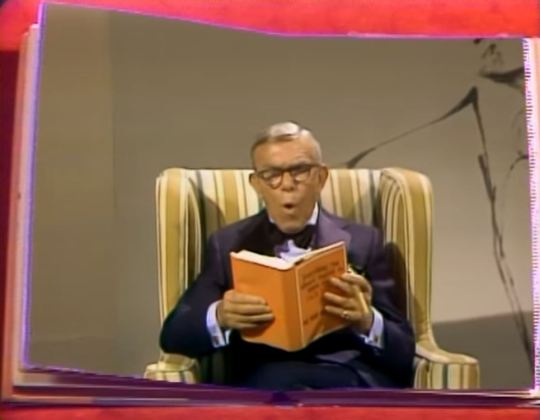
George
Burns
(Himself) was
born Nathan Birnbaum in New York City in January 1896. He married
Gracie Allen in 1926 and the two formed an act (Burns and Allen) that
toured in vaudeville. They had their own hit show “The George Burns
and Gracie Allen Show” first on radio then on CBS TV from 1950 to
1958, airing concurrently with “I Love Lucy.” He appeared as
himself on “The Lucy Show” (S5;E1) in 1966 as well as doing a
cameo on “Lucy and Jack Benny’s Biography” (HL S3;E11) in 1970.
After Allen’s death in 1964, Burns reinvented himself as a solo
act. In 1976 he won an Oscar for playing one of The
Sunshine Boys.
He was also known for playing the title role in Oh,
God! (1978)
and its 1984 sequel Oh,
God! You Devil.
Burns
and Ball appeared on many TV variety and award shows together. He
died at the age of 100.

Phil
Harris
(Himself) was
a bandleader who became a comic radio star as a Jack Benny sidekick
in the 1930s. Although his fondness for booze was largely a creation
of the Benny’s writers, Harris played the part to the hilt. Harris
was mentioned in “Lucy
Gets Jack Benny’s Account” (S6;E6)
when
Benny made a reference to Harris’ persona as a lush. In “Lucy
and Joan” (S4;E4)
Joan
(Joan Blondell) says she’s been in pictures so long she saw Phil
Harris take his first drink. Harris appeared in 1968 episode of “The
Lucy Show” (S6;E20) and played himself in a 1974 episode of “Here’s
Lucy”
(S6;E21).
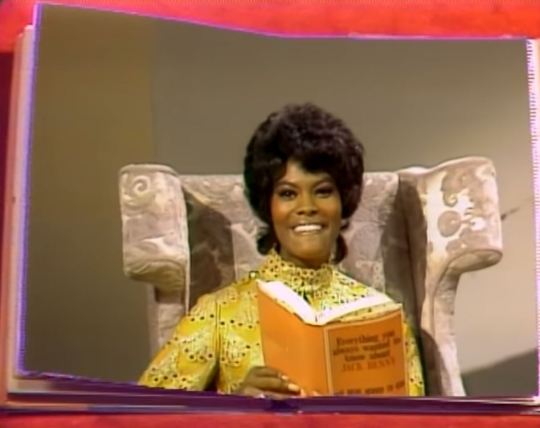
Dionne
Warwick
(Herself) was
born on December 12, 1940 in East Orange, New Jersey. Dubbed ‘the
Princess of Pop’,
Warwick
ranks among the 40 biggest hit makers of the rock era. She is second
only to Aretha
Franklin
as
the most-charted female vocalist of all time, with 56 singles making
the Billboard
Hot
100 between 1962 and 1998.
In 1970 she appeared with Lucille Ball on “The Dean Martin Show”
and in 1984 would attend “An All Star Party for Lucille Ball.”
FEATURING

Dr. David Reuben
(Himself) is
most famous for his book Everything
You Always Wanted to Know About Sex* (*But Were Afraid to Ask)
published in 1969. That book inspired the 1972 film by Woody
Allen of the same name.
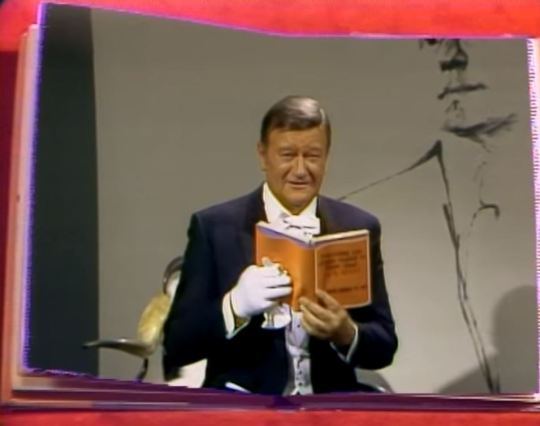
John
Wayne (Himself)
was
born Marion Morrison in 1907. He made his film debut in 1926 and rose
to become an iconic presence in the Western film genre. He was
nominated for three Oscars, winning in 1969 for True
Grit.
He
epitomized rugged masculinity and was famous for his distinctive
voice and walk. His nickname ‘Duke’ came from his own pet
Airedale. Wayne previously worked with Lucille Ball in a 1955 episode
of “I Love Lucy” (S5;E2)
and
a 1966 episode of “The Lucy Show” (S5;E10),
both
titled “Lucy
and John Wayne.”
He died in 1979 at the age of 72.
The
opening announcer introduces him as “John Wayne as Marion Michael
Morrison.”

Bob
Hope
(Juggler, uncredited) was
born Lesley Townes Hope in England in 1903. During his extensive
career in virtually all forms of media he received five honorary
Academy Awards. In 1945 Desi Arnaz was the orchestra leader on Bob
Hope’s radio show. Ball and Hope did four films together. He
appeared as himself on the season
6 opener
of
“I Love Lucy.” He did a brief cameo in a 1964 episode of “The
Lucy Show.”
When
Lucille Ball moved to NBC in 1980, Hope appeared on her welcome
special.
He died in 2003 at age 100.
Bob
Hope does a quick cameo as an inept juggler. He has no dialogue.
SUPPORTING
CAST
Remo
Pisani (Vaudeville
Agent) was
a stunt man and actor who made two appearances on “The Lucy Show.”
He was born in New Jersey in 1919 and died there in 2004.
Tommy
Farrell (Film
Director) would
play Phil
Harris’ Arranger in a 1974 episode of “Here’s Lucy,” his last
of six appearances. Prior to that he was seen on two episodes of
“The Lucy Show.”
David
Westberg
(uncredited)
Bill
Baldwin
(Announcer) was seen on camera in a 1970 episode of “Here’s Lucy”
(S3;E2) but was best known as the fight commentator in the Rocky
movies.
The
other showgirls
in the “Goldwyn Girl” sketch (two of whom have lines), chorus
boys, and the film crew,
are played by uncredited background performers.

The
show also employs a
monkey
and a large dog.
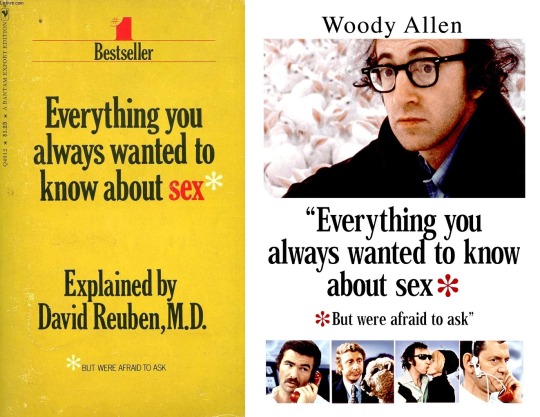
The
title of the special is a nod to the best-selling book Everything
You Always Wanted to Know About Sex* (*But Were Afraid to Ask)
published in 1969. That book would inspired the 1972 film by Woody
Allen. Benny mentions that there will be a film, but does not mention
Woody Allen.
The
show was sponsored by Timex.
This is the second and last of his two specials for the sponsor.
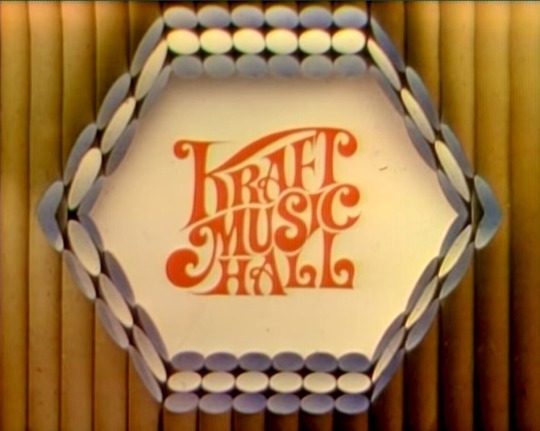
The
special pre-empted “The
Kraft Music Hall.” By
the end of March, the show would air the final episode of the series,
which began in 1967. Over its run “The Kraft Music Hall”
featured Jack Benny, Bob Hope, Dionne Warwick, as well as familiar
faces like Desi Arnaz, Vivian Vance, Lucie Arnaz, and Desi Arnaz Jr.
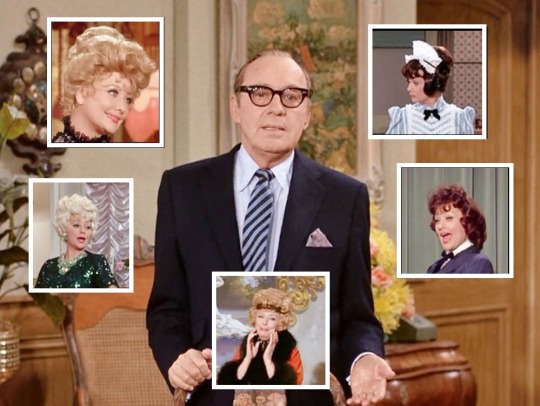
When
this special aired, “Here’s
Lucy”
had just wrapped its third season and Ball was preparing for the
fourth. This special is similar in content to “Lucy and Jack
Benny’s Biography” (HL S3;E11, above), which also took a look at Benny’s
personal history, with Lucy Carter playing all the women in his life.
That episode aired just five months prior to this special, in
November 1970.

The
evening before this special, Lucille Ball appeared on “The
Dick Cavett Show” along
with Carol Burnett and Lucie Arnaz.
After
some introductory remarks, Jack introduces Dr.
David Reuben,
who wrote the book Everything
You Always Wanted To Know…But Were Afraid To Ask.
Jack says he started to read the book, but he fainted on page ten.
Benny asks Dr. Reuben to come in closer to ask him a personal
question:
Benny:
“Can
a man my age take something…. just so he can finish reading the
book?”
Reuben:
“Jack, why are we discussing my book? I mean, this show has nothing
to do with sex. It’s about you.”
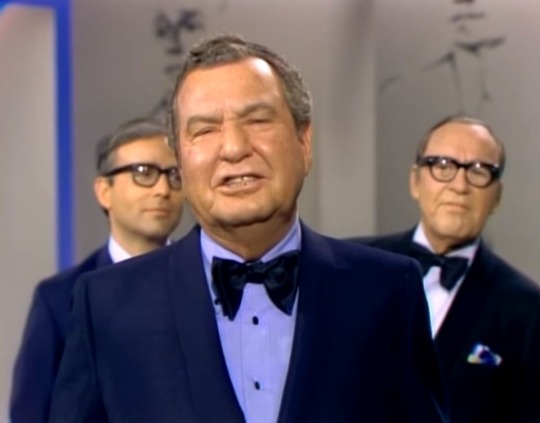
Benny tells the audience that he and Dr. Reuben were both born in Waukegan, Illinois. Phil Harris interrupts their conversation, calling Jack Benny a “stone-age Rhett Butler from ‘Gone With The Wind.’” Harris says that he has read Dr. Reuben’s book and that is on the shelf next to Rebecca of Sunnybrook Farm, which he uses to hide his bottle of bourbon.
Harris
says he wouldn’t have missed Jack’s 20th Anniversary Show for anything. Benny tells him that was four months
ago. Harris has to go call his wife Alice [Faye] but Benny convinces
him to sing a song instead. He starts to sing “That’s
What I Like About the South,” but
Benny stops him saying he’s heard him do that song a thousand times
and that the lyrics make no sense. Benny makes him start again so he
can point out how silly the lyrics are.
Benny:
“How
does your mammy get a cakey by putting a pinch of salty on a hammy
and eggy?”
Harris:
“Does
Sarah Lee tell Betty Crocker?”
Harris
resumes his song and gets as far as the lyrics “doo-wa-diddy” when Benny stops him again. He wheels in a giant map of the USA.

Benny:
“I
want you to show me one place on this map where it says Doo-Wa-Diddy.
I can see Walla Walla, Muskegon, Ashtabula, Waxahatchee, but where in
the name of Aristotle Onassis is Doo-Wa-Diddy?”

Phil
Harris would also sing “That’s What I Like About the South” on a
1974 episode of “Here’s Lucy” (S6;E21).

In a 1968 episode of “The
Lucy Show” (S6;E23) guest star Sid Caesar did a non-musical riff on
the song. Character actor Remo Pisani (Vaudeville Agent) was also
featured in that episode.

After
a commercial break for Timex Fashion Watches ($9.95 to $19.95), Benny
answers questions from his studio audience – all about his age.
George
Burns,
Benny’s closest friend, interrupts and tells him not to talk about
his age. He reminds him about when he wore a dress in the film
Charley’s
Aunt (1941).
Benny leaves the stage to Burns, who says that the audience can ask
him anything about Jack Benny.

In
response to a question about how they first met, a flashback sketch
begins at the Palace Theatre with Bob
Hope
in a wordless cameo as a ‘hopeless’ juggler.

George Burns is the
headliner and his shoeshine boy is Jack Benny. While working, Benny
idly sings (to the tune of Al Jolson’s “A Quarter To Nine”)
“Your
shoes, are gonna twinkle and shine.
This
evening, for a quarter and a dime.”

The
flashback quickly ends and (back on the stage in the present) Benny
says the story was a lie. Burns admits it and the sketch re-starts
(without Hope). This time Benny is an organ grinder – complete with
a live monkey!
This
version also quickly ends when Benny calls Burns a liar. Before he
can tell a third version of the story, Benny pushes him offstage and
a commercial starts for Timex electric watches (“You don’t have to
wind it”).

After
the break, Dionne
Warwick
sings “I
Got Love” by
Gary
Geld and Peter Udell,
a
song she released on her 1970 album Very
Dionne.
During a brief chat with Benny, she says her hometown is a little
place called Watsonville, North Carolina, about five miles south of
Do-Wa-Diddy. The audience applauds the callback to the earlier
sketch. Jack delivers his famous catch phrase “Now
cut that out!”

Warwick sings her encore, “Who
Gets the Guy.”
Warwick released the song by Burt Bacharach and Hal David in 1971.
The single rose to #15 on the Adult Contemporary Charts.
Benny:
“For
some reason, comedy and sex don’t seem to go together. Really, how
many comedians can you think of that can be considered great lovers?
On the other hand, Valentino was no Zero Mostel.”

Benny
says he was never a ladies man, but Lucille
Ball
(nearly 40 minutes into the special) interrupts to says that Benny
always had sex appeal and calls him “blue eyes.” Lucy mentions
his wife, Mary [Livingstone]. Notice that Lucy is wearing the same outfit she wore the night before on “The Dick Cavett Show.”

Lucy
starts to tell a story about her first movie job in a film called
“Goldwyn
Girl” which
is the cue for another flashback. Ball’s first film was actually
titled Kid
Millions
(1934), although she was indeed one of the film’s Goldwyn Girls. They
were named after motion picture producer Samuel Goldman, who founded
a production company that released film through United Artists, and
later RKO. Lucille Ball and Desi Arnaz later bought RKO studios and
renamed it Desilu.

Goldwyn
Girl Lucy comes down a staircase wearing a headdress made of pink
balloons, inadvertently bursting her fellow Goldwyn Girls’ balloons
with her cigarette holder. The scene is instantly reminiscent of
“Lucy Gets Into Pictures” (ILL S4;E18) when Lucy Ricardo got her
first big break in movies as a showgirl.

Jack Benny arrives as the
much-celebrated star of the picture. In reality, Benny’s first
feature film was Chasing
Rainbows
in 1930. The first time Jack Benny and Lucille Ball really appeared
together was on television in 1952. When Benny kisses Lucille’s hand,
all the balloons in her headdress pop.
They
are interrupted by a chorus boy who asks Benny for his autograph.
Benny:
“What’s your name, boy?”
Wayne:
“Marion
Michael Morrison.”
Benny:
“Marion
Michael Morrison? No wonder you’re a chorus boy. You’ll never get
anywhere with a name like that.”
Wayne:
“Well,
I have been thinking of changing it, Mr. Benny. To Wayne.”
Benny:
“Wayne.
That’s not too bad. Wayne. How about Wayne Newton?”
Lucy:
“How
about John Wayne Newton?”
Wayne:
“That’s
worse than Marion Michael Morrison.”
Benny:
“Let
me give you some advice. You’re too big and tall and clumsy to be a
chorus boy. Why don’t you buy yourself a horse, a cowboy suit, and
put a black patch over your eye, and you’ll be in business. Be a
cowboy, get into Westerns and you’ll be a star.”
Wayne:
“But
that takes true grit!”

For
the record, John
Wayne’s
birth name was Marion Robert Morrison. His
middle name was changed to Mitchell (his mother’s maiden name) when
his parents decided to name their next son Robert.
Some sources, however, list him as Marion Michael Morrison. John
Wayne was his professional name. By the time Lucille Ball came to
Hollywood, he had done nearly fifty motion pictures. The 1969 movie
True Grit earned
Wayne his first and only Academy Award.
Benny
gives Marion the perfect name: Myron
C. Handelman.
Although not an exact match, there was a popular comic named Stanley
Myron Handelman who appeared extensively on TV in the early 1970s.
When Wayne exits, Lucy asks for an autograph, and Benny signs the
back of her neck. George Burns appears as a janitor. Jack
immediately stops the sketch and says “THAT’S
how I met George Burns.”

The
scene shifts to young Jack Benny’s palatial Hollywood apartment.
Lucy comes by to “audition” for Benny, but is reluctant to enter his flat unchaperoned. Benny assures her there is
nothing to worry about and she comes in. A moment later a heavy
wrought iron gate immediately drops down in front of the door!

He
tries to give her a huge snifter of brandy, which she refuses. When
he bangs on the wall saying “There’s
nothing to worry about” a
fully made bed drops out of the wall with satin pillowcases saying
“His” and “Hers.” Lucy runs for the door.

Benny:
“It’s
not what you’re thinking.”
Lucy:
“I
know. It’s what YOU’RE thinking. I’m leaving!”
Benny:
“There’s
nothing to worry about, believe me!”
He
bangs the wall again and a second fully made bed drops down in front
of her. She agrees to give him one goodnight kiss, but he faints dead
away. Lucy says
“How do you like that”
and slams her hand on the wall. Cue the third bed!

During
the final Timex commercial (the one where the watch is attached to
the bottom of a snow ski), Benny returns with Dr. Reuben to wrap up
the show. Reuben asks Benny if he’s serious about the violin. John
Wayne brings Benny his Stradivarius (“This
guy really works you to death!”).
To demonstrate his skill, Benny plays Mendelssohn’s
Concerto in E Minor.
As Benny is playing, the studio audience gets up and starts to walk
out as the final credits roll. Benny follows a few of them up the
aisle, playing all the while.
This
Date in Lucy History – March 10th

“Fred
and Ethel Fight”
(ILL S1;E22) – March 10, 1952

“Lucy
and Tennessee Ernie’s Fun Farm”
(S3;E23) – March 10, 1969
Leave a comment